
Stevie - My 9th child
Fatherless at age 8, Type 1 Diabetes at 10
Equipment & Supplies
Unlike many life threatening diseases which take your life quickly, diabetes does so over many decades making it one of the costliest diseases known. However, until later in life when serious effects take their toll for those who do not closely manage their diabetes, the day-to-day costs aren't that bad.
One of our most memorable times was when I took Stevie to the Daddy-Daughter dance. We had to wait an entire year because the previous year sold out but it was worth it. I wasn't able to actually dance because of a back injury but a dear friend who was attending the dance with a granddaughter made sure Stevie did not miss out on anything.
Glucose Test Strips: This is the biggest cost item. There is so much to be made selling test strips that most manufacturers will give you the meter for free. The strips typically cost 50 to 75 cents each and Stevie uses 6 or more a day. As you can see on the right, the strips are quite small. To test, you put a strip in the meter and put a drop of blood on the end of the strip.
Meter: The glucose meter shown here is one of the smallest. We also have a USB cable so we can download Stevie's test results to our home computer. Two meters, one for school and one for home is essential.
Glucagon Syringe: The red container with the big syringe inside is for low blood sugar emergencies, when a child is unable to take sugar orally such as if they are unconscious. We've never used our glucagon syringe but we have one for home and one for school. They cost $100 each and are good for about a year.
Lancet: The black thing that looks like a pen is a lancet, a device for poking your finger to get a drop of blood for the test strips. There are other sizes and shapes. Most are much smaller and don't look like a pen.
Injection Devices: Syringes and Insulin Pens: The small syringes to the right are for injecting insulin at each meal. Believe it or not, the needle is so small, most of the time when I injected with Stevie, I couldn't feel it at all. I felt it sometimes but, even then, the poke of the lancet was worse. Stevie doesn't use syringes any more. She uses a pen. I've shown them here both with and without their caps. She has three pens, one for her overnight insulin and one for her daytime insulin and one for school. They still have a needle but, emotionally, are easier to tolerate for children. Stevie uses a Novopen Jr. which is smaller and has brighter colors.
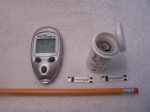
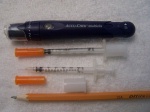
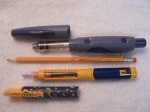
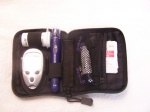
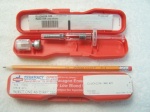
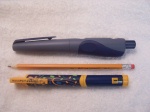
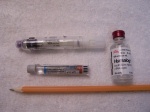
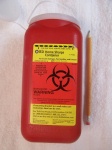
Insulin Pump: Stevie now uses an insulin pump (not shown). You still have to poke yourself with the lancet throughout the day to test but, the advantage of a pump is it has a reservoir of insulin which lasts about 3 days so you only inject once about every three days instead of many times a day.The pump is about the size and shape of a pager.
Insulin: There are many types of insulin. The bottle on the right is for drawing up with a syringe. The two on the left are refills for Stevie's insulin pens. Most Type 1 diabetics, including Stevie, take two types of insulin, a slow acting, long lasting insulin they inject once a day, and a fast acting insulin they inject with every meal.
Sharps container: This is something you need to dispose of the used needles. This is our portable one we carry in our car. We also have a two-gallon size we got from our local trash pickup service.
Not Shown:
Emergency kit: Stevie carries a pack with her at all times with a test meter, strips, and a lancet for testing her blood sugar, and sugar snacks in case her blood sugar is low. They make special sugar tablets for diabetics but we let Stevie choose her own emergency sugars. Anything with 15 grams of refined sugar that is quick to eat will do. A lot of people like Smarties although Stevie does not. Children with diabetes often have low blood sugar so having emergency sugar snacks on them at all times is imperative.
ID Bracelet: This is another imperative. They make hundreds of different designs in addition to the traditional stainless steel bracelet. Stevie has a sports design, made of a nylon strap with the typical medical emblem and the word diabetes. I even met a young man with diabetes who had a diabetes tattoo on his arm.
Cell phone: We consider this to be imperative too although many parents feel otherwise. In our case, had Stevie not had a cell phone when her friend called 911 and nobody came, Stevie could have died.
Ketostix: These look very similar to the glucose test strips but ketostix test urine instead of blood and they are designed to test for the presence of ketones. Unlike the glucose test strips, these are only used when Stevie has extremely high blood sugar which is what causes the life-threatening condition called
Type 1 Diabetes
